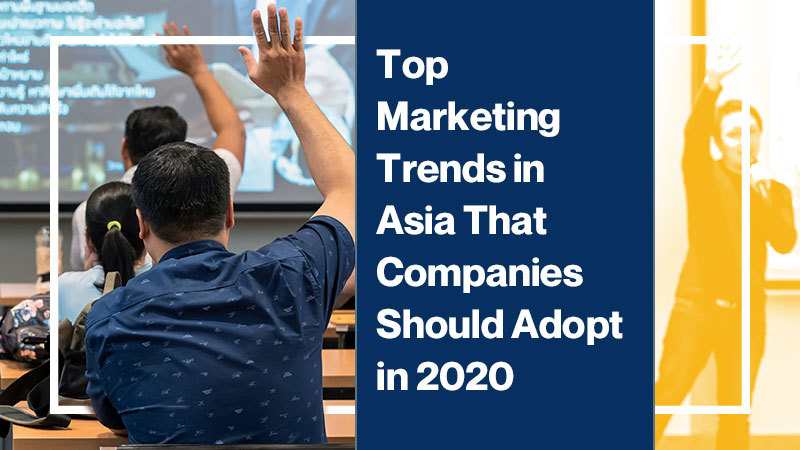Not only are we embracing a new year, but more importantly we are entering a new decade. So, while the year is still young, as B2B marketers we have to stay on top of all the new marketing trends that are emerging and evolving especially here in Asia.
Our goal is to keep you up-to-date with the rising trends this year so you won’t miss out on the opportunity to be one of the first ones to utilize and integrate these into your marketing tactics.
Account-based Marketing
Since the advancement of social media, more and more businesses, your own undeniably included, have integrated this into their marketing strategies. In relation to this, account-based marketing has made its way into it as well. ABM increases your ROI as well as boost trust with your customers and building long-term relationships with your clients.
Though not widely understood just yet, it’s still considered a baby among the new trends. So, if you dive into this, be sure that you develop your own ABM strategy that delivers powerful results and here are the steps on how you can effectively implement ABM into your marketing.
Who is your Audience
This is the first, most important step when starting your ABM campaign. Identify the audience you are trying to target so you won’t waste time and precious resources marketing to an audience who isn’t in the need of your products and services. Take the following into consideration when doing your checklist: type of industry, company size, and target audience’s location.
Get to Know the Market and Account
After you’ve identified the specific account you want to market in, spend some time getting to know them first such as the different challenges they face, milestones they’ve accomplished, and what goals they are looking forward to
Where to run your Campaign
Next, it’s crucial to know where your audience likes to reside. Find out which platform your audience likes to spend their time at and host your marketing campaigns there. Your content will also be greatly affected by the type of platform you’re going to be active in. Another reason why you should know which platform they use the most is so that your audience won’t have to go through the hassle of signing up on another platform just to access your campaign. Most clients and prospects won’t bother if it will require them to deviate from where they’re already comfortable. So, remember to make your campaigns easy to find and easy to access.
Audience-focused Content
Your content should be focused on what will be useful and valuable to your audience. Try to answer questions that your audience may be struggling with so as to provide them with a quality value that they can’t find anywhere else. Make sure that you match your content with the platform that you’re using to have your campaign on.
Run Campaign, Collect Data and Measure Results
When you’ve refined your content and it’s ready to go, go ahead and run your campaign. Depending on the platform you’re using, the campaign will also vary in how it will look. What you want to keep in mind is to closely monitor it while it’s running in order for you to be able to make any changes and adjustments once you notice anything that might seem off or if you don’t get enough traction.
Finally, at the end of your campaign or even while it’s going on, collect all associated data that you gained from the campaign and measure the results in order to measure the ROI of your campaign and for you to determine if your campaign was successful or not.
Aside from sales made during your ABM, you will also have made new connections, so we encourage you to also look through those as well as the new leads that you’ve gathered. Stay connected with these new contacts and build strong relationships with them in order to convert them into a sales-ready customer.
Go Mobile
Our mobile phones have become such an essential part of our daily lives that it’s difficult to go a day without it. Phones used to be restricted to only calling and texting and now we use it for practically everything; It never stops making an impact in our daily lives, and even with the evolution as something as simple as smartwatches is an opportunity for B2B marketers to pull in leads. Keep all these things in mind as new mobile technology will be introduced this year. If your website is not yet mobile compatible, then now is the perfect time to do so. Think of new strategies where you can send messages through other channels other than email.
Faster Analytics
The driving force for analytics in 2020 is going to be Hypothesis analysis. It uses automation to calculate data in such a way that it will help you outline the potential outcomes that you need or are able to achieve. By adopting this into B2B marketing, the hypothesis sequence will collect two sets of data and then compare them. By doing so, the goal is to create an action based on what is statistically the most profitable outcome that you can achieve.
Since it’s not enough anymore to just look at and collect data, but also deeply evaluate which of them are the most beneficial to us. In 2020, definitely lookout for great advancement in analytics to improve the overall understanding of how data can be directed in such a way to achieve the desired goals of your company.
Digital Components to Balance Manual Labor
Staying in the vein of technology, the balance between human resources and the use of technology is also something we should look forward to this year. As much as technology is important to modern marketing, there are times where it’s not as ideal as we think and vice versa for manual labor. It is best to listen to your clients directly as they are the ones that will help steer you in the right direction in regards to setting your standards for how to market to your audience; when to use technology and when to put your human resources above it.











